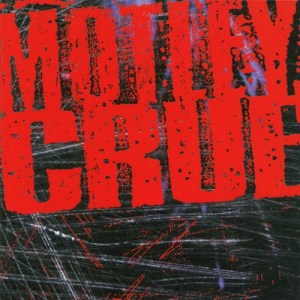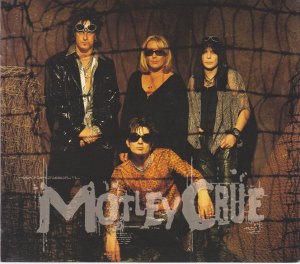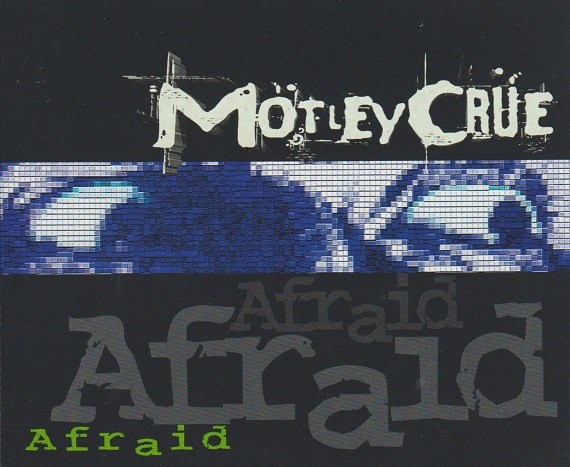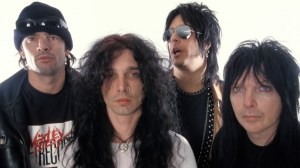GETTING MORE TALE #611: Afraid
1989: A clean and sober Motley Crue take over the world. Dr. Feelgood climbs to #1 and the band rivals Bon Jovi and Def Leppard in the popularity stakes.
1990: Motley continue to tour and rock them all, while announcing their next album will be a “greatest hits”.
1991: Decade of Decadence is released, keeping Motley on the charts. The new single “Primal Scream” is well received.
1992: In a shock announcement, Vince Neil is fired from the band. Unfortunately Motley are not the only rock band to lose their singer at the beginning of the 90s.
1993: Vince Neil’s solo debut Exposed is greeted by warm reviews. Motley continue to toil in the studio with new singer John Corabi.
1994: Five years after Dr. Feelgood, the re-imagined Motley finally return with the self-titled Motley Crue. Corabi blows ’em away, but the album fails to sell. Motley is forced to do a scaled down tour while the CD dropped off the charts.
 This was the state of the Crue in the mid 90s. They had released an incredible album. Today, many fans rate it in the top three, or even at the #1 spot. My near-legendary Record Store cohort T-Rev agrees. “To me, they sounded more like a hard rock band than a hair metal band, because of that album.”
This was the state of the Crue in the mid 90s. They had released an incredible album. Today, many fans rate it in the top three, or even at the #1 spot. My near-legendary Record Store cohort T-Rev agrees. “To me, they sounded more like a hard rock band than a hair metal band, because of that album.”
Absolutely true. They stepped far beyond the preconceived notions of Motley Crue. Guitars were detuned, lyrics were topical or personal. Tracks like “Smoke the Sky” might have passed for Soundgarden. On the other side of the coin, “Misunderstood” was an epic power ballad featuring an orchestra and Glenn fucking Hughes. There wasn’t a weak track in the bunch, but plenty of variety.
Most fans didn’t embrace it at the time, and instead moved on to current bands. Back then, nobody was interested. No Vince, no Motley? No way. Corabi was absolutely the right guy at the right time. Motley added his rhythm guitars and songwriting abilities, not to mention far more aggressive singing. The band had only gotten better. But by recording an uncompromising album with an unknown singer, they were indeed taking a chance. It didn’t pay off. When I was working at the Record Store, there was a giant pile of unsold Motley Crue CDs taking up space. They sat next to an equally tall pile of David Lee Roth’s Your Filthy Little Mouth. All the kings seemed to have been usurped.
At the Record Store, I first befriended the aforementioned T-Rev. The fact that both of us loved the Motley album didn’t hurt. T-Rev was the only person I knew who appreciated what they did. He loved that huge overproduced drum sound. Back in 1989, everybody had a Motley Crue T-shirt in the highschool halls. In 1994, we couldn’t get anyone to listen.
Through 1995 and 1996, magazines reported that Motley were back in the studio, working on a followup with Corabi. Bob Rock was back in the producer’s chair and the band wrote new songs such as “Personality #9”, “Let Us Prey”, “La Dolce Vita” and “The Year I Lived In A Day”. Things seemed to be going well, but record company pressure was intense. Bob Rock’s style was now passé and he was fired. Engineer Scott Humphrey was promoted to producer, and electronics began to dominate.
The pressure was not only on Motley Crue, but focused directly on John Corabi. Elektra records were eager to get Vince Neil back, a true “star”. John was getting frustrated in the studio while this was going on. Nothing he sang seemed to be good enough for Motley Crue anymore. He was asked to sing like Oasis or the Sisters of Mercy. John suggested that he just play rhythm guitar while they get Vince Neil to sing. Somehow, this made its way into the rumour mill. Before John Corabi was eventually fired, T-Rev and I had heard that Motley were considering this very same five-piece lineup. What a glorious sounding thing that could have been.
 Ultimately the band fired John and got Vince back. They attempted to piece together the album that they’d been recording and re-recording and re-re-recording again. Mick Mars was frustrated as well, as his guitar parts kept getting rejected and remixed. In particular, Mars did not function well with Scott Humphrey.
Ultimately the band fired John and got Vince back. They attempted to piece together the album that they’d been recording and re-recording and re-re-recording again. Mick Mars was frustrated as well, as his guitar parts kept getting rejected and remixed. In particular, Mars did not function well with Scott Humphrey.
Personally speaking, I lay these problems at the hands of Scott Humphrey. I read the book The Dirt, and that’s certainly where the band lay most of the blame. Have a look at Humphrey’s credits though. Lots of records loaded with electronics, like Rob Zombie’s Hellbilly Deluxe and Tommy Lee’s solo stuff. Humphrey started out as a keyboard player and programmer, and I think that high-tech style does not work with Motley Crue. That’s my personal opinion, never having met Scott Humphrey. I did, however, have a customer at the Record Store who knew Scott Humphrey, who is actually from Kitchener Ontario.* “Motley Crue were the problem,” he told me. “They were messed up on drugs.” They were also unfocused musically.
On January 27 1997, the reunited original Motley Crue performed on the American Music Awards. Mere months after being teased by a similar Van Halen reunion on the MTV Awards, I was relieved that Motley were playing a song rather than just standing there. But what the hell song was it?! Some strange, techno-y version of “Shout at the Devil”? It was strange, unexpected and underwhelming. Hey, cool, it was a fresh spin on an old classic. But…why?
We soon found out. The album Generation Swine came out on June 24 1997. As usual, T-Rev and I got it a few days in advance. “It sucks!” he warned me. Of the first single “Afraid”, he said “It sounds more like Def Leppard than Motley Crue.”
“Afraid” is the best song on the album, which does frankly suck. In a single stroke Motley went from one of their best albums, to one of their very worst. It was astounding how desperate they sounded, trying to incorporate these influences that have nothing to do with Motley Crue. The loops and samples and effects ruined many of the songs, but some just weren’t that good to begin with. This considered, it was an even bigger surprise that Nikki Sixx and Tommy Lee were singing lead vocals too. Sixx’s silly opener “Find Myself” was a nauseating faux-punk novelty song. Generation Swine was also unfocused in the extreme, and the muddying effects didn’t help. The electronic treatments on the drums rendered them limp, compared to the massive sound of 94’s Motley Crue. Absolutely everything on Generation Swine was inferior to Motley Crue.
Three CD singles were released for “Afraid”, which was remixed so many times trying to get it right, that they used some of the various versions as bonus tracks. The album version is fine enough, and in this one instance, the electronics enhance the song. I’d rather hear “Afraid” with the effects than without.
What did other fans think? When Generation Swine was new, one of my customers wanted to hear it before buying. “I saw that Vince Neil is back. Have you heard it?” he asked me, and I told him the truth. He was sceptical of my review, but changed his mind upon hearing it. “It doesn’t sound like them,” he said, and he’s right. I then cajoled him into listening to the 1994 album. He didn’t want to, because it didn’t have Vince Neil, but agreed to give it a shot.
Guess which album he bought? Motley ’94.
At least there’s some redemption, if only temporarily. During the Christmas season of 1998, T-Rev once again called me up to tell me about Motley Crue. There was a new compilation out, called Greate$t Hit$ [review coming tomorrow]. This time, there were two new songs: “Enslaved” and “Bitter Pill”. Both were produced by Bob Rock.
“The new songs aren’t bad,” said T-Rev. “A lot better than Generation Swine. Not as good as ‘Primal Scream'”
Right again, T-Rev. Not bad. An improvement, but not as good as what they did the first time out. That was enough for me to buy the CD. Not for Trevor, though.
I think Motley Crue were on the right track with “Enslaved” and “Bitter Pill” after the failure of Generation Swine. They obviously knew that album didn’t work, so they went back to the last thing that did. Both songs are growers, and still raise a smile to hear. Unfortunately Motley Crue blew it again. Tommy Lee and Vince Neil had a dust-up at an airport, and Lee split. He was replaced by former Ozzy Osbourne drummer, Randy Castillo.**
Fans like T-Rev and myself always supported the 1994 album, and today we’ve been justified. More and more fans have realised the quality of that CD, and increasingly hold it in high esteem. There’s something about that CD, and I’m afraid that Motley Crue never came close to touching it since.
Tommy Lee, John Corabi, Nikki Sixx & Mick Mars
* Fun fact! T-Rev’s mom dated Scott Humphrey!
** In a very sad turn of events, Castillo never got to tour with Motley Crue. He became ill and died of cancer on March 26, 2002 at age 51. His replacement, Hole’s Samantha Maloney, did the tour and resultant live video.



Fun write-up Mike and agree on all counts. And so does Chris Akin in his soon to be released book which might interest you Mike :)
http://www.chrisakinbooks.com/cause-effect-motley-crue
LikeLiked by 1 person
Thanks for the tip dude! I think that’s awesome — I will want that book. FOR SURE. Thanks again Wardy.
LikeLike
Did the greatest hits actually have the $$ in the name?
They’re not even being subtle about the motivation!
LikeLiked by 1 person
I’m “afraid” they did include the $ signs. But that’s not the only cash grab you’ll be reading about tomorrow in relation to that album! You will see….
LikeLiked by 1 person
I totally ignored Motley Crue at that point but now I’m interested. You have given me insight as to which album to listen to and which to avoid.
LikeLiked by 1 person
Motley 94 – you will love it! Everyone does.
LikeLiked by 1 person
I’ll have to check it out then, thanks.
LikeLike
Well I think Swine could have been scaled back in tracks and buena solid album.
Over the years this thing has grown on me!
Afraid/Black Beauty and Let us Prey are killer tracks…
But like i have always stated Sixx follows trends and he did so on this record but it still is a decent listen …
Once in a blue moon kinda way!
LikeLiked by 1 person
Deke this is a very good point. Scale it back to say 7 great tracks and I can happily listen to it.
Sixx has been successful following trends…a lot like Mr. Simmons!
LikeLiked by 1 person
Yeah thats a post in itself with those two guys..man…
LikeLike
Sixx didn’t start to follow trends up until – ironically enough – the 1994 Corabi album. Before that, he and Motley were always one step ahead of the trends…
LikeLike
Great write-up, I learned a lot from this! I agree on the 1994 album, it rocked while everyone else didn’t give it a chance and stayed listening to grunge. I actually own that one twice – I bought the CD completely forgetting that it’s on the Music To Crash Cars To (something like that) boxed sets. Ah well! Good on you and T-Rev for supporting it in the face of all that apathy.
LikeLike
I actually like Generation Swine….
What’s wrong with me?
LikeLike